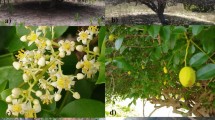Abstract
The soil-borne bacterium Bacillus thuringiensis (Bt) is an important biological agent used against human and plant pests and diseases. Seven Jordanian Bt isolates, which have been analysed for toxicity against important pests, were also differentiated through serotyping. In this study, they were analysed at the molecular level using random amplified polymorphic DNA markers. Five more international strains were incorporated in the analysis. The DNA markers used showed high polymorphism among the isolates tested. However, the data did not align completely with earlier serotyping for most isolates. Therefore, it is recommended to engage several analyses (e.g. biochemical and molecular) when classifying newly surveyed Bt isolates in the world.
Similar content being viewed by others
References
Abu-Dhaim E, Al-Banna L, Khyami-Horani H (2006) Evaluation of some Jordanian Bt strains against two species of root-knot nematodes. Jordan J Agric Sci 1:49–57
Al-Banna L, Khyami-Horani H (2004) Nematicidal activity of two Jordanian strains of Bacillus thuringiensis on root-knot nematodes. Nematol Mediterranea 32:41–45
Bourque SN, Valero JR, Lavoie MC, Levesque RC (1995) Comparative analysis of the 16S to 23S ribosomal intergenic spacer sequences of Bacillus thuringiensis strains and subspecies and closely related species. Appl Environ Microbiol 61:1623–1626
Carneiro RMDG, De Souza IS, Belarmino LC (1998) Nematicidal activity of Bacillus spp. strains on juveniles of Meloidogyne javanica. Nematol Brasileira 22:12–21
de Barjac H, Bonnefoi A (1962) Essai de classification biochimique et serologique de 24 24 souches de Bacillus du type B. thuringiensis. Entomophaga 7:5–31
Gaviria Rivera AM, Priest FG (2003a) Molecular typing of Bacillus thuringiensis serovars by RAPD-PCR. Syst Appl Microbiol 26:254–261
Gaviria Rivera AM, Priest FG (2003b) Pulsed field gel electrophoresis of chromosomal DNA reveals a clonal population structure to Bacillus thuringiensis that relates in general to crystal protein gene content. FEMS Microbiol Lett 223:61–66
Hansen B, Damgaard PH, Eilenberg J, Pedersen JC (1998) Molecular and phenotypic characterization of Bacillus thuringiensis isolated from leaves and insects. J Invert Pathol 71:106–114
Khyami-Horani H, Katbeh-Bader A, Mohsen ZH (1996) Mosquito larvicidal toxicity of endospore-forming bacilli isolated in Jordan. Dirasat Med Biol Sci 23:140–144
Khyami-Horani H (2002a) Haemolytic and mosquitocidal endotoxin activity of Jordanian strains of Bacillus thuringiensis and B. sphaericus. Dirasat Pure Sci 29:235–241
Khyami-Horani H (2002b) Toxicity of Bacillus thuringiensis and B. sphaericus to laboratory populations of Drosophila melanogaster (Diptera: Drosophilidae). J Basic Microbiol 42:105–110
Levy H, Fisher M, Ariel N, Altboum Z, Kobiler D (2005) Identification of strain specific markers in Bacillus anthracis by random amplification of polymorphic DNA. FEMS Microbiol Lett 244:199–205
Leyns F, Borgonie G, Arnaut G, De Waele D (1995) Nematicidal activity of Bacillus thuringiensis isolates. Fundam Appl Nematol 18:211–218
Marroquin LD, Elyassnia D, Griffitts JS, Feitelson JS, Aroian RV (2000) Bacillus thuringiensis (Bt) toxin susceptibility and isolation of resistance mutants in the nematode Caenorhabditis elegans. Genetics 155:1693–1699
Matarante A, Baruzzi F, Cocconcelli PS, Morea M (2004) Genotyping and toxigenic potential of Bacillus subtilis and Bacillus pumilus strains occurring in industrial and artisanal cured sausages. Appl Environ Microbiol 70:5168–5176
Priest FG, Kaji DA, Rosato YB, Canhos VP (1994) Characterization of Bacillus thuringiensis and related bacteria by ribosomal RNA gene restriction fragment length polymorphism. Microbiology 140:1015–1022
Rückert A, Ronimus RS, Morgan HW (2004) A RAPD-based survey of thermophilic bacilli in milk powders from different countries. Int J Food Microbiol 96:263–272
Sanchis V, Chaufaux J, Lereclus D (1996) Amelioration biotechnologique de Bacillus thuringiensis: les enjeux et les risques. Ann Institut Pasteur/Actual 7:271–284
Sharma RD (1994) Bacillus thuringiensis: a biocontrol agent of Meloidogyne incognita on barley. Nematol Brasileira 18:79–84
Schnepf E, Crickmore N, Van Rie J, Lereclus D, Baum J, Feitelson J, Zeigler DR, Dean DH (1998) Bacillus thuringiensis and its pesticidal crystal proteins. Microbiol Mol Biol Rev 62:775–806
Tessier C, David J, This P, Boursiquotm JM, Charrier A (1999) Optimization of the choice of molecular markers for varietal identification in Vitis vinifera L. Theor Appl Genet 98:171–177
Vilas-Bôas GFLT, Vilas-Bôas LA, Lereclus D, Arantes OMN (1998) Bacillus thuringiensis conjugation under environmental conditions. FEMS Microbiol Ecol 25:369–374
Acknowledgments
This study was funded by a joint grant from Hamdi Mango Center (No. 04200012) and the Deanship of Academic Research, University of Jordan, Jordan (No. 826). The authors would like to thank Miss A. Abdeen and for technical assistance.
Author information
Authors and Affiliations
Corresponding author
Rights and permissions
About this article
Cite this article
Sadder, M.T., Khyami-Horani, H. & Al-Banna, L. Application of RAPD technique to study polymorphism among Bacillus thuringiensis isolates from Jordan. World J Microbiol Biotechnol 22, 1307–1312 (2006). https://doi.org/10.1007/s11274-006-9177-6
Received:
Accepted:
Published:
Issue Date:
DOI: https://doi.org/10.1007/s11274-006-9177-6




